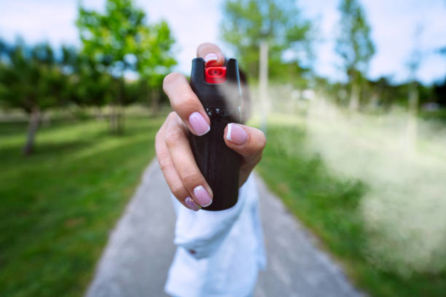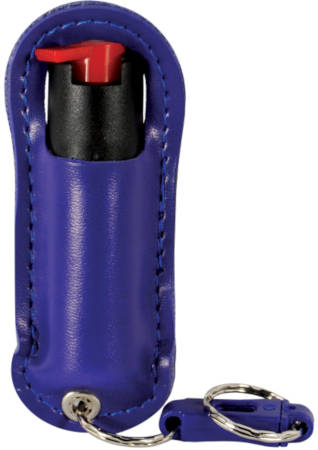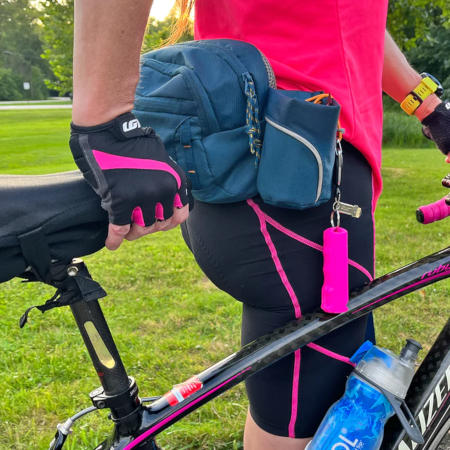The Pros and Cons of Carrying Pepper Spray

The world is not always a safe playground. Many threats lurk around corners, and it's essential to have a reliable line of defense on hand. One such protective tool that has garnered immense popularity over the years is pepper spray - a compact, easy-to-use device associated with personal safety and self-defense. But like any other tool, it comes with its pros and cons. Throughout this blog post, we'll deep-dive into the benefits and drawbacks of carrying pepper spray for your personal safety, equipping you with the knowledge needed to decide if it’s the right security measure for you.
Carrying pepper spray can provide a means of self-defense for individuals seeking an alternative to lethal force. It is portable, easily accessible, and legal in most areas. However, there is a risk of accidental discharge or misuse, it may have limited effectiveness in windy conditions, and it does not work on individuals under the influence of drugs or alcohol. Before choosing to carry pepper spray, it is important to understand local laws and regulations, as well as properly educate oneself on its use and operation.

Pepper Spray: A Legal Primer
Before diving into the benefits and considerations of carrying pepper spray, it's crucial to have a solid understanding of the legal aspects surrounding its use. While pepper spray is legal for self-defense purposes in all 50 states and Washington D.C., there are certain conditions and restrictions that vary from state to state.
In general, individuals who are 18 years old or older can purchase and carry pepper spray. However, it's important to be aware that some states have additional requirements such as size restrictions, concentration limits, and age restrictions. For example, certain states may permit the purchase of pepper spray only if it meets a specific concentration level or if it is below a certain size limit.
Let's take California as an example. In California, individuals must be at least 18 years old to possess pepper spray, and the container size cannot exceed 2.5 ounces.
To ensure compliance with the law and avoid any potential legal issues, it is essential to familiarize yourself with the specific guidelines in your state regarding pepper spray.
Understanding Your Local Laws
To navigate the legal landscape surrounding pepper spray effectively, it is vital to understand the laws specific to your locality. While pepper spray is generally legal in most states for self-defense purposes, certain places may have regulations that restrict its use or possession in specific situations or locations.
For instance, some states prohibit carrying pepper spray in certain public buildings or establishments frequented by children like schools or childcare centers. Additionally, airlines have restrictions on carrying pepper spray onboard commercial flights for safety reasons.
It's important to note that these regulations are put in place to ensure public safety and prevent misuse of pepper spray in sensitive areas.
Consulting local statutes and authorities will provide you with comprehensive information about where you can legally carry pepper spray and any additional requirements or restrictions specific to your area.
In New York, for example, it is legal to possess and carry pepper spray for self-defense purposes. However, there are certain guidelines for its use and possession. Pepper spray in New York must be purchased from licensed firearms dealers or pharmacists, and the total amount of pepper spray one can possess is limited.
Taking the time to educate yourself about your local laws will help you use pepper spray responsibly while maximizing your personal safety.
Think of understanding local laws regarding pepper spray as reading the manual of a complex device. By being familiar with the guidelines and regulations, you ensure that you can navigate safely within the framework provided by your state.
Armed with knowledge about the legality of carrying pepper spray and understanding the specific laws in your area, let's now explore the benefits and considerations associated with carrying this self-defense tool.
The Benefits of Carrying Pepper Spray
When it comes to personal safety, pepper spray has been a popular choice for self-defense for many years. It offers a range of benefits that make it a valuable tool in deterring attackers and providing individuals with an added sense of security.
Imagine walking alone at night in an unfamiliar area and suddenly sensing a potential threat approaching. In such a situation, having pepper spray on hand can be a game-changer. Its immediate availability and ease of use allow you to quickly defend yourself by incapacitating the attacker, giving you vital time to escape and seek help.
Pepper Shot 1.2% MC 1/2 oz Halo Holster Blue
One of the primary advantages of carrying pepper spray is its portability. Most pepper sprays are compact, lightweight, and can easily fit in a pocket, bag, or attached to a keychain, ensuring that it's always accessible when needed. This convenience allows individuals to carry it with them consistently, providing a consistent layer of protection.
Another notable benefit of pepper spray is its legal availability in many places. Unlike firearms or other self-defense weapons that may require permits or have restrictions, pepper spray is widely accessible to the general public. However, it's important to note that regulations may vary depending on your location, so understanding local laws regarding its purchase, possession, and use is crucial.
Pepper spray is also highly effective in incapacitating attackers temporarily. The chemical compound found in pepper spray causes temporary blindness, respiratory distress, and intense burning sensations on the skin and eyes. This powerful combination disorients the aggressor and allows the potential victim an opportunity to escape or call for assistance.
One of the most significant benefits of carrying pepper spray is the enhanced personal safety it provides.
Enhanced Personal Safety
Personal safety is paramount in every aspect of our lives. Having the ability to defend ourselves when faced with potential threats greatly enhances our overall well-being. Pepper spray serves as a non-lethal self-defense tool that can level the playing field in situations where physical confrontation is a possibility.
Consider a scenario where an individual is being followed by someone with malicious intent. As the persistence of the aggressor increases, fear and anxiety begin to escalate. In such moments, pepper spray acts as a deterrent and can potentially prevent physical harm. The simple act of displaying the canister or warning the potential attacker of its presence can often be enough to discourage them from pursuing further.
Additionally, carrying pepper spray provides individuals with a sense of empowerment and peace of mind. Knowing that you have a tool capable of incapacitating an assailant gives you the confidence to navigate through unfamiliar areas or potentially dangerous situations. This enhanced feeling of safety can allow individuals to live their lives more freely without constantly fearing for their well-being.
It's important to note that while pepper spray is an effective self-defense tool, it does have limitations. Factors such as wind conditions, range, and effectiveness on individuals under the influence of drugs or alcohol can impact its overall efficacy. However, arming yourself with pepper spray and familiarizing yourself with its proper use can significantly increase your chances of successfully defending yourself.
Non-Physical Self-Defense
When it comes to personal safety, non-physical self-defense methods are gaining popularity for their effectiveness and ease of use. Pepper spray is one such option that falls under this category. Unlike physical self-defense techniques that require strength and martial arts skills, pepper spray offers a practical and accessible means of protection for individuals of all ages and physical abilities.
Carrying pepper spray provides a sense of security in potentially dangerous situations. It can be easily stored in a pocket, purse, or attached to a keychain for convenient access whenever needed. The compact size and lightweight nature make it portable and discreet, allowing you to carry it with you at all times without drawing attention.
Pepper Spray is Easy to Carry, Lightweight, and Easily Accessible
In addition to its convenience, pepper spray is widely available and legal in many areas, making it an accessible self-defense tool for individuals concerned about their personal safety. Its ease of use allows anyone to quickly deploy it when faced with an attacker, regardless of their prior experience or training.
Pepper spray's effectiveness as a non-physical self-defense tool lies in its ability to incapacitate an assailant temporarily. When sprayed onto the face, it causes intense burning, respiratory distress, and temporary blindness. This reaction provides victims with crucial seconds or minutes to escape from potential harm and seek help.
While there are other non-physical self-defense options available, such as personal alarms or safety whistles, pepper spray stands out for its immediate and direct impact on the assailant. Its potency allows individuals to neutralize threats without engaging in physical confrontation or risking their own safety.
While pepper spray offers numerous advantages in terms of non-physical self-defense, it's crucial to understand the potential pitfalls associated with its use.
- Pepper spray is an effective and accessible non-physical self-defense tool that offers a practical means of protection for individuals of all ages and physical abilities. Its ease of use, wide availability, and immediate impact on the assailant make it a popular choice for personal safety. However, it's important to understand the potential risks associated with its use to ensure proper handling and deployment.
Potential Pitfalls of Pepper Spray
While pepper spray can be effective in deterring attackers, it's important to acknowledge the potential pitfalls that come with its use. Understanding these drawbacks will help individuals make informed decisions about incorporating pepper spray into their personal safety strategies.
One potential pitfall is the risk of accidental discharge. Improper handling or a faulty canister can lead to the spray being released unintentionally, causing harm to the user or innocent bystanders. It's important to familiarize yourself with the operation and safety features of your pepper spray canister to minimize this risk.
Another concern is the potential for misuse or abuse. Carrying pepper spray should be taken seriously, as using it inappropriately or without just cause can have legal consequences. It's essential to understand the laws and regulations regarding the purchase, possession, and use of pepper spray in your specific area to ensure you are within legal boundaries.
Additionally, it's worth noting that pepper spray may have limited effectiveness in windy conditions or when facing individuals under the influence of drugs or alcohol. Factors such as wind direction and speed can impact the spray pattern and range, potentially reducing its effectiveness. Moreover, certain individuals may have a higher tolerance or resistance to the effects of pepper spray due to physiological differences or substance usage.
Lastly, there is a possibility that an attacker could seize control of the pepper spray and use it against the victim. This highlights the importance of maintaining situational awareness and employing proper self-defense techniques alongside carrying pepper spray as part of a comprehensive personal safety plan.
Imagine finding yourself in a scenario where your attacker manages to grab hold of your pepper spray before you could deploy it. In such instances, having additional knowledge on self-defense techniques like strikes or learning how to disarm an assailant becomes all the more valuable.
While these potential pitfalls exist, it's important to recognize that they are not unique to pepper spray alone. Any self-defense tool, including physical techniques like martial arts or weapons like firearms, carries inherent risks and considerations that need to be thoroughly understood.
Having explored both the advantages and potential pitfalls of pepper spray, it's clear that it is essential to weigh these aspects carefully and make an informed decision when incorporating pepper spray into your personal safety strategy.
Accidental Discharge
Accidental discharge is one of the concerns that individuals have when it comes to carrying pepper spray. The fear of inadvertently activating the spray can be understandably alarming. However, it's important to note that modern pepper sprays are designed with safety mechanisms to prevent accidental discharge. These safety features often include a thumb or finger grip, where you need to apply pressure in a specific way to activate the spray. Additionally, many pepper sprays also come with a locking mechanism or safety cap that helps to prevent accidental activation.
While the chances of accidental discharge may be minimal when using a reliable pepper spray, it is still essential to handle it with care and understand how it works. Familiarize yourself with your specific pepper spray model and practice using it responsibly in controlled environments so that you become comfortable and confident in its use. By doing so, you can reduce the risk of any unintended discharge.
For instance, Emma, a college student who carries pepper spray for personal protection, takes time each month to go over the instructions and practice using her pepper spray. This routine not only helps her feel more secure but also ensures she is well-prepared in case she ever needs to use it.
| Accidental Discharge: Pros | Accidental Discharge: Cons |
|---|---|
| Modern pepper sprays have safety mechanisms to prevent accidental discharge | There is still a slight risk of unintended activation if not handled properly |
| Regular practice and familiarization with the product reduce the risk | In stressful or emergency situations, there may be a higher chance of accidental discharge |
While accidental discharge is a legitimate concern, let's now explore another aspect related to carrying pepper spray: potential misuse and associated risks.
Potential Misuse and Associated Risks
While carrying pepper spray can provide a sense of security, there is always a potential risk for misuse or abuse. It is crucial to understand that pepper spray should be used as a self-defense tool in situations where there is an immediate threat to your personal safety. Engaging in any form of misuse or using it as a means of intimidation can have serious consequences, both legally and ethically.
Misusing pepper spray not only puts you at risk but also others around you. It's important to remember its purpose – self-defense, not aggression.
Furthermore, it's essential to consider the potential risks associated with using pepper spray in certain situations. One concern is the limited range and effectiveness in windy conditions. Wind can blow the spray off course, reducing its effectiveness in incapacitating an attacker. This emphasizes the need for the user to be aware of their surroundings and the direction of the wind when considering deploying pepper spray.
Sarah, a jogger who often goes for runs by the beach, ensures she takes wind direction into account when carrying her pepper spray. If the wind is blowing towards her face, she adjusts her route slightly or carries the spray in a way that minimizes the chance of getting affected by it.
Another point to consider is the possibility of an attacker disarming you and using your own pepper spray against you. While rare, there have been instances where attackers have managed to gain control of a victim's pepper spray during an altercation. This highlights the importance of self-defense training and situational awareness as complementary measures alongside carrying pepper spray.
Additionally, it's worth noting that individuals under the influence of drugs or alcohol may exhibit reduced sensitivity to the effects of pepper spray. While it can still be effective for many people, it may not have the desired effect on everyone in such situations.
Think of pepper spray like a fire extinguisher; when used appropriately, it can effectively put out small fires. However, if misused or used incorrectly, it can potentially worsen the situation or cause unintended harm.
Now that we've explored the potential risks and concerns associated with carrying pepper spray, let's move on to discussing key considerations when choosing pepper spray as a personal safety tool.
Key Considerations When Choosing Pepper Spray
When it comes to personal safety, choosing the right pepper spray is essential. There are several key considerations to keep in mind before making a purchase. These factors will help ensure that you select the most suitable pepper spray for your specific needs and circumstances.
Firstly, distance is an important consideration. The range of the pepper spray refers to how far it can effectively shoot its contents. It's crucial to choose a pepper spray that has a range appropriate for your intended use. If you're primarily using it for self-defense during outdoor activities like hiking or jogging, a spray with a longer range may be necessary. On the other hand, if you're mainly looking for protection in indoor spaces, a shorter-range pepper spray might suffice.
Another vital factor is strength or potency. Pepper sprays typically contain a certain percentage of oleoresin capsicum (OC), which is the active ingredient responsible for temporarily incapacitating an attacker. The higher the percentage of OC, the greater the effectiveness of the pepper spray. However, it's important to note that some states have restrictions on the maximum strength allowed for civilian use. Be sure to check local laws and regulations before purchasing.
Spray pattern type is another consideration when choosing pepper spray. Different patterns offer varying degrees of coverage. For example, foam or gel patterns are ideal for indoor use as they provide better control and reduce the risk of cross-contamination in enclosed spaces. On the other hand, fog or stream patterns are more suitable for outdoor use as they create a wider dispersal area and can deter attackers from a distance.
Size and portability are practical aspects to consider as well. Pepper sprays come in various sizes, including small keychain versions that can easily fit into a pocket or purse for convenient access. Larger options may provide more shots or increased potency but might be bulkier to carry around.
Additional features like keychains or holsters can also enhance the convenience and accessibility of your pepper spray. Having it readily available in a secure and easily accessible manner can be crucial during an emergency situation.
Lastly, brand reputation and reliability are factors to consider. Research reputable brands that have a track record of producing reliable and effective pepper sprays. Well-known brands like Pepper Shot and Mace Brand have established themselves as trusted providers of quality self-defense products.
Taking all these considerations into account will help ensure that you choose the most suitable pepper spray to meet your personal safety needs. Remember, personal safety is a top priority, and making an informed decision when selecting your pepper spray is essential.
Now that we've explored the key considerations for choosing pepper spray, let's dive into the specifics of spray pattern, range, and potency.
Spray Pattern, Range, and Potency
When evaluating pepper sprays, understanding the concepts of spray pattern, range, and potency is crucial.
The spray pattern refers to how the pepper solution is emitted from the canister. Different patterns include fog, stream, foam, or gel. A fog pattern creates a mist-like coverage area, ideal for close-quarters situations where accuracy may be less important. Stream patterns produce a focused stream that provides greater accuracy over longer distances. Foam or gel patterns cling to the target upon contact, minimizing blowback in indoor environments.
The range of a pepper spray determines how far it can effectively reach a target. It's important to choose a range appropriate for your intended use and the specific environment in which you anticipate needing it. For example, if you primarily require protection during outdoor activities, opt for a pepper spray with a range of at least 10 feet or more.
The potency of a pepper spray is measured by its concentration of oleoresin capsicum (OC), the active ingredient responsible for its effects. The OC percentage varies among pepper sprays, with higher concentrations generally causing more intense effects. However, be mindful of local laws and regulations that may place limits on the maximum OC concentration permitted for civilian use.
It's important to strike a balance between range and potency when selecting your pepper spray. While a longer range allows you to defend yourself from a distance, a higher potency ensures greater effectiveness upon contact. Consider your specific needs and circumstances to find the right combination of range and potency for your personal safety requirements.
For instance, imagine you are a runner who often goes jogging alone early in the morning. You might want a pepper spray with a longer range so that you can deter potential threats from a distance. On the other hand, if you primarily need protection in closed spaces like parking garages or narrow hallways, a foam or gel pattern may be more suitable as it reduces the risk of cross-contamination and provides better control.
By understanding spray patterns, range, and potency, you can make an informed decision when choosing your pepper spray. These factors will ensure that you select a product that aligns with your specific needs and enhances your personal safety.
Add your comment now!
Post Comment





